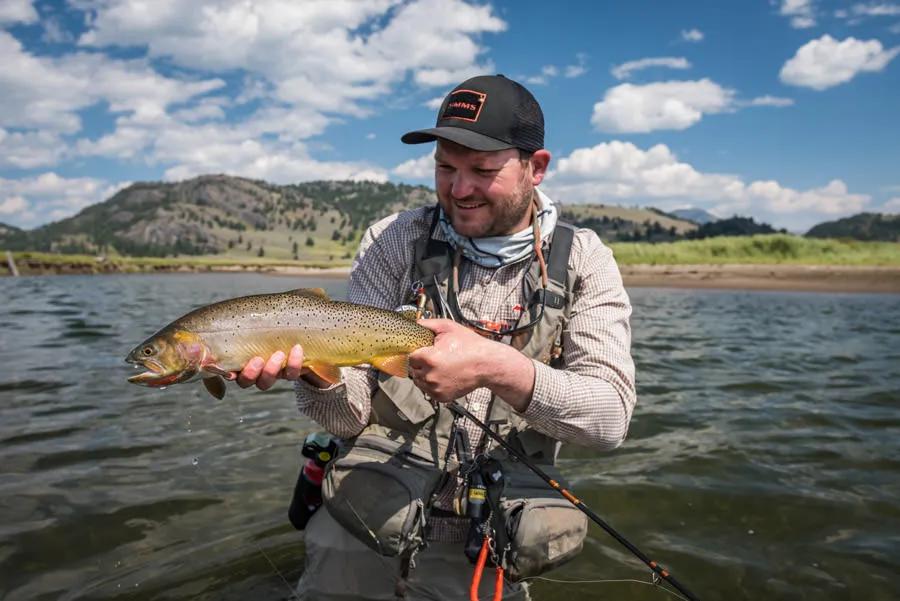
When fly fishing Yellowstone National Park in August, savvy anglers begin working harder to get off the beaten path. The height of tourist season sees relatively high fishing pressure on the easily accessible, famous rivers. If you are willing to lace up your hiking boots, however, you can find plenty of lightly fished spots full of aggressive trout. Hatches are sporadic at best and the fish are mainly concentrated on terrestrial insects such as grasshoppers, beetles, and ants. Bright sunshine and low water will sometimes drive the fish down deep, so be sure to have some streamers to dredge the deeper pools. The Madison Drainage is still too warm for fishing so you will want to base yourself in the northern part of the park. Lets take a look at some of my top bets for success during August.

Yellowstone River
The Yellowstone River in both the Grand and Black Canyon is my top choice for August fishing year in and year out for several reasons. First, these swift canyon waters rarely warm to the point of hurting the fishing. Morning and early afternoon are always best but the fishing rarely shuts down completely. Second, there is virtually no road access to either canyon, meaning the fish see far fewer flies than other locations. Third, the river contains a high population of Cutthroat Trout, a species that loves to feed on the surface. Another thing I really enjoy about fishing the Yellowstone in August is that as the water drops throughout the summer, the river takes on a lot more character. What were brawling rapids in early July are now wadeable riffles and boulder gardens. The fish really spread out as well, giving the angler many more options of places to fish. Fly wise, don’t expect any significant hatches so come prepared with a good assortment of attractor dries and terrestrial patterns. Fishing a large hopper or foam attractor is the most fun way to fish but even fish in more remote areas can wise up to these as the summer goes along. Make sure to carry some smaller stuff in sizes 12-16 as well. Classic patterns like Stimulators and PMX’s work great. If the dry fly bite slows, as it sometimes does on hot, bright afternoons, try fishing a streamer slow and deep.

Gardner River
The Gardner River is another good August bet. The roadside water below the Boiling River can be too warm at times, but morning fishing in this stretch is usually good. The fish will usually eat dries from the get go, but be prepared to nymph fish if you are hitting the water at first light. A stonefly with your favorite caddis dropper is all you really need. This stretch of river hosts a great caddis hatch in the evenings all the way to dark, provided the water is not too warm. Bring a stream thermometer and do not fish if the water is over 70 degrees. If the water is cool enough, go eat dinner in town and then return to the river for the show. I like an olive parachute caddis trailing a small emerger. The section of river from the Boiling River upstream to Osprey Falls will typically fish better in the midday hours. This is a swift, pocketwater environment so choose flies that float well and are easy for you to see. Think attractors and terrestrials. Focus on the calmer pockets and eddies created by the many boulders. Like the Yellowstone, this a canyon stretch of river that requires a hike to access.
Lamar Valley- Lamar River, Slough Creek, Soda Butte Creek
All three of these famous meadow streams see tremendous pressure during August. The good news is that they also all contain stretches that are tougher to reach if you are willing to put in the time and effort. If you are fishing the most popular stretches during August, make sure to downsize your flies and tackle. Think 10-12 ft 5x leaders and small ants and beetles. Downsize your hoppers to a #12 or #14. It pays to experiment with different patterns, sizes, and colors as these fish see flies everyday. This time of year, it is important to move and fish very slowly and deliberately. You aren’t going to walk up to a pool, toss a couple casts, then move on to the next one and be successful. Spend a couple minutes observing the pool before you begin to fish it. Watch for movement under the water or a stray rise to let you know where the fish are holding. If your fly line crosses over a fish it’s game over so understanding where the fish are is critical. Generally speaking, the fish will be less wary in more broken water and stretches of river that are further from the road. If you can score a camping permit, back country sections of the Lamar and Slough offer excellent fishing.

Small Streams
I have always enjoyed fishing small creeks and August is prime time for these types of fisheries. These streams are ice cold and the short growing season really puts the fish on the feed. A 3wt or 4wt rod and a box of attractor dries are all you need and I enjoy this minimalist approach. All of the major streams and rivers, including those listed above, are fed by a myriad of small creeks, many of which contain good trout populations. Most of the fish will be small, under 10 or 12 inches, but they are colorful and feisty and a skilled angler can really rack up the numbers most days. This type of fishing is not for everyone but it is a great change of pace from the larger and more famous rivers discussed above.
